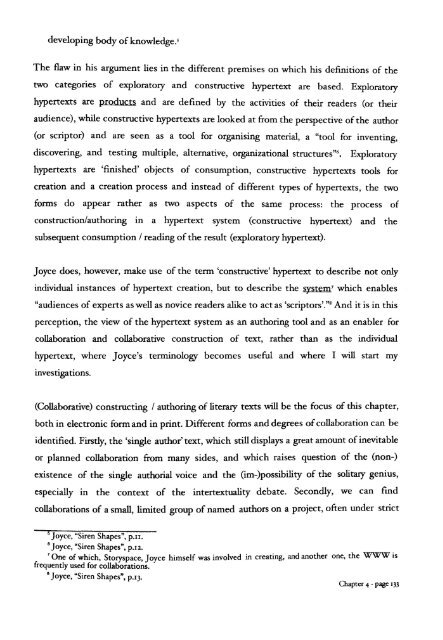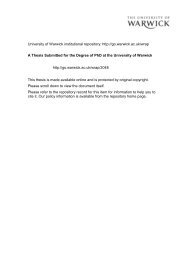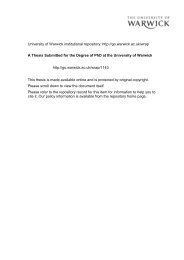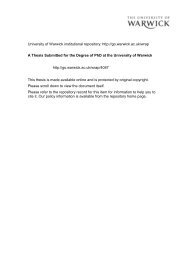From Page to Screen - WRAP: Warwick Research Archive Portal ...
From Page to Screen - WRAP: Warwick Research Archive Portal ...
From Page to Screen - WRAP: Warwick Research Archive Portal ...
Create successful ePaper yourself
Turn your PDF publications into a flip-book with our unique Google optimized e-Paper software.
developing body ofknowledge.'<br />
The flaw in his argument lies in the different premises on which his definitions of the<br />
two categories of explora<strong>to</strong>ry and constructive hypertext are based. Explora<strong>to</strong>ry<br />
hypertexts are products and are defined by the activities of their readers (or their<br />
audience), while constructive hypertexts are looked at from the perspective ofthe author<br />
(or scrip<strong>to</strong>r) and are seen as a <strong>to</strong>ol for organising material, a "<strong>to</strong>ol for inventing,<br />
discovering, and testing multiple, alternative, organizational structures'". Explora<strong>to</strong>ry<br />
hypertexts are 'finished' objects of consumption, constructive hypertexts <strong>to</strong>ols for<br />
creation and a creation process and instead of different types of hypertexts, the two<br />
forms do appear rather as two aspects of the same process: the process of<br />
construction/authoring in a hypertext system (constructive hypertext) and the<br />
subsequent consumption / reading ofthe result (explora<strong>to</strong>ry hypertext).<br />
Joyce does, however, make use of the term 'constructive' hypertext <strong>to</strong> describe not only<br />
individual instances of hypertext creation, but <strong>to</strong> describe the system 7 which enables<br />
"audiences of experts as well as novice readers alike <strong>to</strong> act as 'scrip<strong>to</strong>rs'." And it is in this<br />
perception, the view of the hypertext system as an authoring <strong>to</strong>ol and as an enabler for<br />
collaboration and collaborative construction of text, rather than as the individual<br />
hypertext, where Joyce's terminology becomes useful and where I will start my<br />
investigations.<br />
(Collaborative) constructing / authoring of literary texts will be the focus of this chapter,<br />
both in electronic form and in print. Different forms and degrees ofcollaboration can be<br />
identified. Firstly, the 'single author'text, which still displays a great amount ofinevitable<br />
or planned collaboration from many sides, and which raises question of the (non-)<br />
existence of the single authorial voice and the (im-)possibility of the solitary genius,<br />
especially in the context of the intertextuality debate. Secondly, we can find<br />
collaborations of a small, limited group of named authors on a project, often under strict<br />
5 Joyce, "Siren Shapes", p.rr,<br />
eJoyce, "Siren Shapes", p.I2.<br />
7 One of which, S<strong>to</strong>ryspace, Joyce himself was involved in creating, and another one, the WWW is<br />
frequently used for collaborations.<br />
8 Joyce, "Siren Shapes", P.I3.<br />
Chapter 4 - page 133





